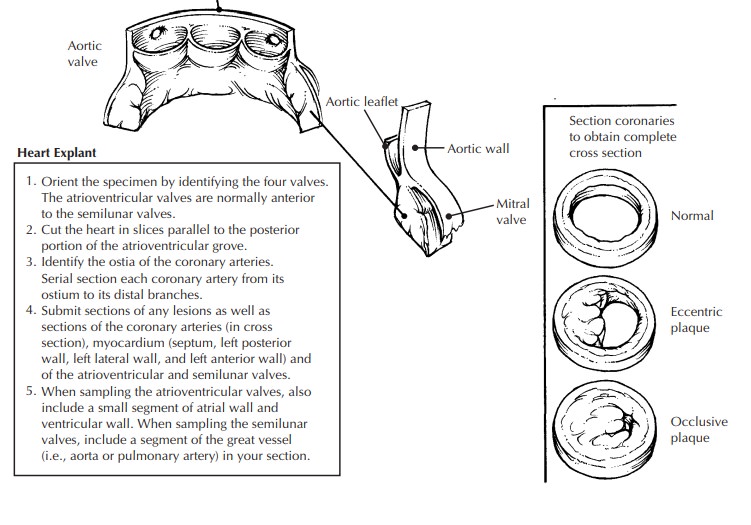Chapter: Surgical Pathology Dissection : The Cardiovascular, Respiratory System
Endomyocardial Biopsy: Surgical Pathology Dissection
Endomyocardial Biopsy
Endomyocardial
biopsy is still the gold standard for monitoring the allograft. Biopsies are
also frequently performed to determine the etiology of heart failure in nontransplanted
patients. The tissue is usually procured with a bioptome through either the
jugular or the femoral vein. There is evidence that with three pieces only 95%
of inflammatory infiltrates are detected. How-ever, if four pieces are
examined, up to 98% of infiltrates are detected. The working formulation for
heart allograft monitoring therefore recom-mends examination of at least four
pieces of tissue.4Documenting the number of
biopsy spec-imens received is therefore important. The speci-mens are handled
differently depending on the timing or the reason for the biopsy.
Following
a few simple rules ensures
optimal preservation of the tissue for diagnostic analysis. Minor modifications
to these rules for specific tests or research protocols can be made without
disrupting the work flow in the heart biopsy suite. Some helpful hints include
the following.
1. Plan ahead. Take into account that the work-ing
formulation recommends “four to six undi-vided pieces of tissue,” “one piece
frozen,” and “no tissue routinely fixed for electron micros-copy.” Commonly,
the fixative of choice is 10% phosphate-buffered formalin. Alternatively,
fix-ation can be done in glutaraldehyde for micros-copy or in other fixatives
that preserve antigens for immunohistochemistry studies.
2. The tissue should not be handled with forceps
or divided with a scalpel. The tip of an intravenous catheter or syringe needle
is usu-ally a good instrument for picking up the bi-opsy. Squeezing the tissue
can produce artifacts that upon microscopic examination render it
un-interpretable.
The tissue should be fixed immediately in the
desired fixative that has been allowed to reach room temperature. Cold fixative
enhances contraction band artifacts. The tissue should not be allowed to sit
for long periods of time on filter paper, gauze, or any other surface
im-pregnated with saline. Saline is a poor solutionfor preserving the
morphology of myocardium, as it readily creates artifacts.
4.
During the first six weeks after transplan-tation, at least one
piece of tissue should be frozen. The working formulation recommends that the
tissue be frozen in OCT compound (Miles Inc., Diagnostics Division, Elkhart,
IN, USA).4We prefer to freeze the tissue using iso-pentane, which
should be chilled to 2208C in a small 1.8-ml cryogenic vial. The biopsy tissue is then
immersed in this prechilled isopentane cryo-vial, the cap is tightened, and the
container is immersed in liquid nitrogen. At this point the tissue can
be processed for immunofluores-cence or stored at 2808C for
future study.
5.
In the nontransplanted patient, one or more
pieces of tissue can be snap-frozen for special studies (e.g.,
immunohistochemistry, in situ nucleic
acid hybridization, polymerase chain reaction).
For
transplant biopsies the working formula-tion4
recommends: “a minimum of three step levels through the paraffin block with at
least three sections of each level.” Similar handling is adequate for
nontransplant specimens. Slides should be stained routinely with hematoxylin
and eosin; additional unstained slides should be obtained for other stains to
avoid having to “face” the paraffin block again and thus minimize tissue loss
due to technical handling.
For
heart transplant biopsies the working for-mulation does not require routine
submission of tissue from cardiac allograft biopsies for electron microscopy.
However, for diagnostic “cardio-myopathy work-up” biopsies, it is important to
procure at least one specimen and fix it in glutaraldehyde. If the biopsy is
received in forma-lin and there are more than four biopsy pieces, one may be
transferred to glutaraldehyde and submitted for electron microscopy. In cases
of suspected adriamycin toxicity, consideration should be given to submitting
all of the tissue for electron microscopy.



Related Topics